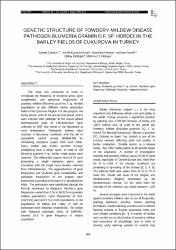| dc.contributor.author | Zeybek, Ahmet | |
| dc.contributor.author | Khan, Mohd Kamran | |
| dc.contributor.author | Pandey, Anamika | |
| dc.contributor.author | Günel, Aslıhan | |
| dc.contributor.author | Erdoğan, Oktay | |
| dc.contributor.author | Akkaya, Mahinur S. | |
| dc.date.accessioned | 2020-11-20T14:53:44Z | |
| dc.date.available | 2020-11-20T14:53:44Z | |
| dc.date.issued | 2017 | |
| dc.identifier.issn | 1018-4619 | |
| dc.identifier.issn | 1610-2304 | |
| dc.identifier.uri | https://hdl.handle.net/20.500.12809/2058 | |
| dc.description | WOS: 000395724300043 | en_US |
| dc.description.abstract | This work was conducted in order to investigate the frequency of virulence genes, gene complexities, and pathotype frequencies of powdery mildew (Blumeria graminis f. sp. hordei) populations on two different barley production fields in the Cukurova Region. For this purpose, the barley leaves, prior to the pre-harvest period, which were infected with pathogen at the sexual period developmental stage as Cleistothecium were collected in 2007 and stored in the laboratory at room temperature. Pathogenic isolates were obtained in laboratory conditions with the aid of susceptible control variety (Bulbul-89) by stimulating ascospore output from each foliar. Every isolate was further purified through multiplying from a single spore. A total of 138 Blumeria graminis f. sp. hordei single spores were obtained. The differential isogenic lines of 25, each possessing a single resistance genes were inoculated with the single spore isolates obtained from Cleistothecium. The aggressiveness of gene frequencies and virulence gene complexities, and pathotype frequencies of the isolates were determined according to the scale 0-4, developed by Welz. The pathotypes were established through the formula developed by Habgood. Virulence gene frequencies varied from 0 % to 94.33 % in powdery mildew populations. Gene frequencies of Val, (Va7+Vk) were at 0.0 % in both populations. In the populations of Adana and Hatay 47 and 56 pathotypes were obtained, respectively. The isolate with Habgood pathotype index of 04667601 showed 14.8 % gene frequency in Adana population. | en_US |
| dc.description.sponsorship | DOSAP Program of METU; State Planning Organization, DPTTurkiye Cumhuriyeti Kalkinma Bakanligi [DPT2004K120750] | en_US |
| dc.description.sponsorship | We gratefully acknowledge Dr. Mogens S. Hovmoller and ICARDA for providing the Blumeria graminis f. sp. hordei races and Barley differential lines, respectively. We also thank to Adnan Menderes University for using their facilities. This work was funded by the DOSAP Program of METU and State Planning Organization, DPT (Project No. DPT2004K120750). | en_US |
| dc.item-language.iso | eng | en_US |
| dc.publisher | Parlar Scientific Publications (P S P) | en_US |
| dc.item-rights | info:eu-repo/semantics/openAccess | en_US |
| dc.subject | Barley | en_US |
| dc.subject | Blumeria Graminis F. Sp Hordei | en_US |
| dc.subject | Virulence Gene Frequency | en_US |
| dc.subject | Pathotype Frequency | en_US |
| dc.subject | Habgood Analysis | en_US |
| dc.title | GENETIC STRUCTURE OF POWDERY MILDEW DISEASE PATHOGEN BLUMERIA GRAMINIS F. SP HORDEI IN THE BARLEY FIELDS OF CUKUROVA IN TURKEY | en_US |
| dc.item-type | article | en_US |
| dc.contributor.department | MÜ, Fen Fakültesi, Biyoloji Bölümü | en_US |
| dc.identifier.volume | 26 | en_US |
| dc.identifier.issue | 1A | en_US |
| dc.identifier.startpage | 906 | en_US |
| dc.identifier.endpage | 912 | en_US |
| dc.relation.journal | Fresenius Environmental Bulletin | en_US |
| dc.relation.publicationcategory | Makale - Uluslararası Hakemli Dergi - Kurum Öğretim Elemanı | en_US |


















